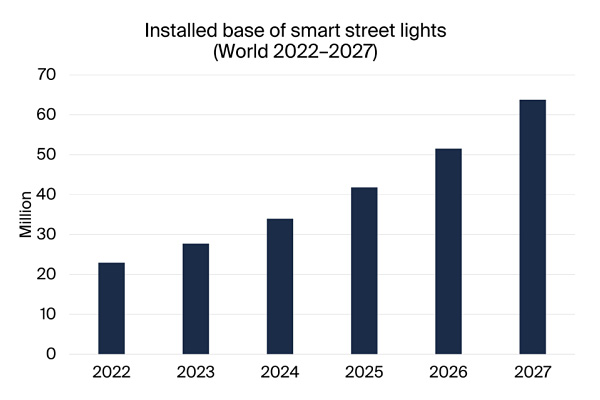By 2027, the global installed base of smart street lights will reach 64 million

By 2027, the global installed base of smart street lights will reach 64 million

According to the latest research report from IoT analysis company Berg Insight, by the end of 2022, the number of smart street lights installed worldwide will reach 23 million.
By the end of 2027, the installed capacity will reach 63.8 million, with a compound annual growth rate (CAGR) of 22.7%.
Europe leads the adoption of smart street lighting technology and will account for 35% of global installations by 2022. North America is catching up with Europe and is growing strongly and will account for about 37% of global shipments by 2022. Meanwhile, nearly half of the smart streetlight installed base outside Europe and North America is located in this region.
As of the third quarter of 2023, Signify is the world's leading smart street light supplier, with nearly 4.9 million connected street lights, accounting for 18% of global installations. The company climbed to the top of the list after acquiring former market leader Telensa in July 2021. The top three also include America's Itron and China's Frontage Technology, of which most of Frontage Technology's lighting controllers are deployed in the domestic market. Collectively, the top three suppliers account for almost one-third of global independently controlled smart streetlight installations. Additionally, Itron is a global leader in networking.
 By 2027, the global installed base of smart street lights will reach 64 million
By 2027, the global installed base of smart street lights will reach 64 million
Major smart street lighting companies also include Quantela, Dimonoff, Ubiquia and LED Roadway Lighting from North America; Schréder from Belgium; Rongwen Energy Technology Group from China; Revetec and Umpi from Italy; Flashnet (Lucy Group) from Romania; Lucy from the UK Zodion (Lucy Group) and SSE; and ST Engineering Telematics Wireless in Singapore/Israel.
William Ankreus, IoT analyst at Berg Insight, said the smart street lighting market has experienced significant growth in 2022 and the first quarter of 2023, after a slowdown in 2021 due to supply chain constraints and delays in new project tenders. Slow down.
The growing awareness among cities and municipalities of the energy costs and environmental issues associated with street lights has acted as a catalyst for the growth of the smart street lights market. While proprietary RF network platforms have been the dominant type of connectivity for smart streetlight deployments, the market is now clearly tilting toward increased use of cellular communications in several regions of the world.
Mr. Ankreus continued:
The simplicity and plug-and-play nature of cellular connectivity make it an increasingly popular alternative for smart street lighting deployments and is expected to be the fastest-growing connectivity technology.
Download Report Brochure: Global Smart Street Lighting Market